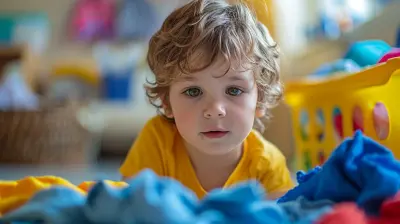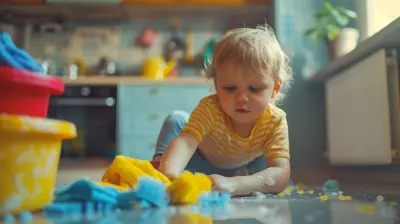How to Teach Kids the Power of Patience
19 May 2025
Patience isn’t just a virtue—it’s a life skill that helps children develop resilience, emotional intelligence, and self-control. However, in a world where instant gratification is the norm, teaching kids patience can feel like an uphill battle. Whether it’s waiting for their turn on the playground, sitting through a long car ride, or handling frustration when things don’t go their way, patience plays a crucial role in their growth.
So, how can we help our kids embrace patience without turning it into a dreaded lesson? Let’s dive into some practical, fun, and effective strategies! 
Why Is Patience Important for Kids?
Before we jump into the how, let’s talk about the why. Why should kids—who seem to have boundless energy—slow down and practice patience?1. Develops Emotional Control – Kids who learn patience are better at managing frustration and disappointment.
2. Improves Social Skills – Waiting for their turn, listening before speaking, and understanding others’ perspectives all require patience.
3. Encourages Delayed Gratification – Research shows that children who can delay gratification tend to have higher academic success and better decision-making skills later in life.
4. Builds Resilience – Life is full of waiting—whether it’s for a holiday, a birthday, or a dream job. Patience teaches kids how to handle life’s natural pauses with grace.
Now that we know why patience matters, let’s move on to how we can teach it in a way that actually sticks! 
1. Lead by Example
Kids are like tiny sponges—they absorb everything we do and say. If they see us losing our cool in traffic, getting frustrated when the Wi-Fi slows down, or complaining about waiting in line, they’ll pick up on that impatience.Try these simple habits to set a good example:
- Take a deep breath instead of reacting immediately.
- Use words like “It’s okay, we can wait” or “Good things take time.”
- Show patience when dealing with them—especially when they’re learning or struggling.
Your actions speak louder than words, so be the role model they need! 
2. Use Fun Games and Activities
Teaching patience doesn’t have to feel like a boring lecture. Kids learn best through play, so why not make it fun?Games That Teach Patience:
- Red Light, Green Light – Helps kids practice self-control.- Simon Says – Encourages them to listen carefully and wait for the right moment.
- Puzzles or Board Games – These require kids to take turns and think critically, reinforcing patience naturally.
- Baking Together – Waiting for the cookies to bake teaches delayed gratification with a sweet reward!
When learning feels like play, kids don’t even realize they’re building a valuable skill. 
3. Introduce “Wait Time” Gradually
Expecting a child to suddenly master patience overnight is unrealistic. Instead, introduce “wait time” in small, manageable chunks.How to Do This:
- Start Small – Ask them to wait for a minute before giving them a snack.- Use a Timer – Set a timer and let them watch as the minutes pass. This shows them that waiting isn’t endless!
- Stretch Their Waiting Time – Once they handle a minute well, increase it to two, then five, and so on.
This gradual approach makes patience feel achievable rather than overwhelming.
4. Teach the “Pause and Breathe” Technique
When kids get impatient, they often react emotionally—whining, crying, or getting frustrated. Teaching them a simple pause and breathe technique can help them handle these moments better.Simple Breathing Exercise for Kids:
1. Take a deep breath in through the nose.2. Hold it for three seconds.
3. Slowly blow it out like blowing out a candle.
4. Repeat a few times.
This technique not only helps with patience but also builds emotional regulation skills.
5. Use Stories and Books to Illustrate Patience
Kids love stories, and they can be a powerful tool to teach life lessons. There are many books that highlight patience in a fun way.Great Books About Patience:
- Waiting Is Not Easy! by Mo Willems (A hilarious story about waiting.)- The Very Impatient Caterpillar by Ross Burach (Teaches patience through a funny caterpillar’s journey.)
- Llama Llama Red Pajama by Anna Dewdney (Encourages kids to be patient at bedtime.)
Reading these books together and discussing the characters’ challenges can help kids relate and learn without feeling lectured.
6. Help Them Set Long-Term Goals
Instant gratification is tempting for kids, but teaching them about long-term rewards can help them develop patience over time.How to Encourage Long-Term Thinking:
- Saving Money – Encourage them to save for a toy instead of buying it immediately.- Growing a Plant – Watching a plant grow teaches patience in a visual, hands-on way.
- Learning a New Skill – Whether it’s riding a bike or playing an instrument, remind them that progress takes time.
When kids see that patience leads to big payoffs, they’ll be more willing to practice it.
7. Turn Waiting into a Positive Experience
Instead of making waiting feel like a punishment, turn it into an opportunity for creativity and mindfulness.Ideas to Make Waiting Fun:
- Play “I Spy” – A great way to pass time in a long line.- Sing a Song or Tell a Story – Keeps their mind engaged.
- Keep a “Waiting Bag” – Fill a small bag with coloring books, puzzles, or small toys for times when patience is required.
By shifting their focus, kids will learn that waiting isn’t so bad after all!
8. Praise Their Patience
Positive reinforcement is a game changer. When your child demonstrates patience, acknowledge and praise it.How to Reinforce Patience:
- “Wow, you waited so patiently for your turn! I’m really proud of you.”- “I noticed you stayed calm when we had to wait in traffic. That’s awesome!”
- “Great job waiting for the cookies to bake—it was worth it, right?”
When kids see patience being celebrated, they’ll be more motivated to practice it.
Final Thoughts
Teaching kids patience isn’t about forcing them to wait—it’s about helping them understand the value of waiting. By modeling patience, making waiting enjoyable, and reinforcing their progress, we can equip them with a skill that will serve them well for life.It’s okay if they struggle at first. Patience is like a muscle—the more they use it, the stronger it gets. So, take a deep breath, embrace the small wins, and remember: good things take time!
all images in this post were generated using AI tools
Category:
Life Skills For KidsAuthor:

Maya Underwood
Discussion
rate this article
3 comments
Giovanna Foster
Model patience; they learn by example.
June 3, 2025 at 4:18 PM

Maya Underwood
Absolutely! Children often mirror our behaviors, so demonstrating patience in our actions sets a powerful example for them to follow.
Devin Lamb
This article offers insightful strategies for instilling patience in children, emphasizing the importance of modeling behavior and creating opportunities for practice. By incorporating fun activities and setting realistic expectations, parents can foster resilience and understanding in their kids. A thoughtful approach that can truly benefit family dynamics and child development.
May 24, 2025 at 2:28 PM

Maya Underwood
Thank you for your thoughtful comment! I'm glad you found the strategies valuable for fostering patience and resilience in children. Your insights on modeling behavior and creating engaging activities are spot on!
Tabitha McMaster
Teaching patience? Just remember, kids will only wait as long as their snacks are involved!
May 23, 2025 at 2:46 PM

Maya Underwood
Absolutely! Snacks can be a great motivator to help kids practice patience in fun ways.



